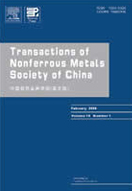Synthesis and characterization of arginine-modified and
europium-doped hydroxyapatite nanoparticle and its cell viability
europium-doped hydroxyapatite nanoparticle and its cell viability
(1. Medical Experiment Center in the 3rd Xiangya Hospital, Central South University, Changsha 410013, China;
2. State Key Laboratory of Powder Metallurgy, Central South University, Changsha 410083, China;
3. Research Center for Medical Material and Instruments, Central South University, Changsha 410013, China)
2. State Key Laboratory of Powder Metallurgy, Central South University, Changsha 410083, China;
3. Research Center for Medical Material and Instruments, Central South University, Changsha 410013, China)
Abstract: The arginine-modified and europium-doped hydroxyapatite nanoparticles (HAP-Eu) were synthesized by hydrothermal synthesis. The prepared nanoparticles were characterized by transmission electron microscopy (TEM), X-ray diffractometry (XRD), Fourier transform infrared (FTIR) and zeta potential analyzer. The cell viability of HAP-Eu was tested by image flow cytometry. The results indicated that HAP-Eu is short column shapes and its size is approximately 100 nm, its zeta potential is about 30.10 mV at pH of 7.5, and shows no cytotoxicity in human epithelial cells and endothelial cells.
Key words: hydroxyapatite; arginine; europium; hydrothermal synthesis; cell viability

